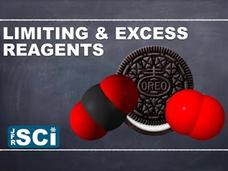Bozeman Science
Limiting Reactants and Percent Yield
Mr. Andersen explains the concept of a limiting reactant (or a limiting reagent) in a chemical reaction. He also shows you how to calculate the limiting reactant and the percent yield in a chemical reaction.
TED Talks
TED: Why healthy soil matters now more than ever | Jane Zelikova
From nourishing our foods to storing massive amounts of carbon, soil is teeming with diverse microbial life that could slow global warming. Climate change scientist Jane Zelikova calls for agricultural practices that protect Earth's soil...
Curated Video
GCSE Chemistry - What is a Limiting Reactant? Limiting/Excess Reactants Explained #27
Limiting and Excess Reactants Explained. Often, in chemical reactions there will be less of one reactant that the other - we call this one the limiting reactant because how much reaction can take place. Whereas the more abundant reactant...
Curated Video
Solving Limiting Reactant Practice Problems!
In this video we walkthrough 3 limiting reactant practice problems step by step and show you how to solve them!
Bozeman Science
The Rate-Limiting Step
In this video Paul Andersen explains why the slowest elementary step in a chemical reaction is the rate-limiting step. This step can be used to determine the overall rate law of the chemical reaction.
Bozeman Science
Stoichiometry
In this video Paul Andersen explains how stoichiometry can be used to quantify differences in chemical reactions. The coefficients in a balanced chemical equation express the mole proportions in that reaction. These values can be used to...
Professor Dave Explains
Limiting Regents and Percent Yield
Chemistry doesn't always work perfectly, silly. Molecules are left over when one thing runs out! Also we never get all of the products that we thought we might by doing the math. You gotta know about the limiting reagents and the percent...
Professor Dave Explains
Practice Problem: Limiting Reagent and Percent Yield
Once we get the hang of stoichiometric calculations, we get a curve ball. Limiting reagents? Not all of the reactants will react? We might not get as much product as we expect? Let's practice identifying the limiting reagent, calculating...
Curated Video
Striking a Balance : Investigating Reaction Rate and Stoichiometry
Influence of Stoichiometry on Rate of Reaction. Rate of Reaction & Stoichiometry part 1
Catalyst University
Labeling Parts of a Reaction Coordinate Diagram
Labeling Parts of a Reaction Coordinate Diagram
Visual Learning Systems
The Nature of Electricity: Moving Charges
This video describes the basic role that atoms play in creating electrical charges, as well as the nature and creation of static electricity. Various methods of charging are discussed, emphasizing the role that insulators and conductors...
msvgo
Stoichiometry
It explains the concept of Stoichiometry, Concentration of Solution, Mole Fraction, Molality & Molarity.
Socratica
Chemistry: Limiting Reactants aka Limiting Reagents
An installment from the Socratica chemistry video series explains limiting reactants. It includes multiple example problems to demonstrate how scientists control for these limiting reagents.
Bozeman Science
Limiting Reactants and Percent Yield
Viewers watch while the narrator explains limiting reactions through the familiar example of a recipe. He then describes why it is necessary to use moles to solve these problems rather than just relying on diagrams. The video ends...
JFR Science
Limiting and Excess Reagents
Sometimes things are just left over. An informative video in the JFR Science series highlights limiting and excess reactants in a chemical reaction. It explains the process of solving stoichiometry problems with limiting reactants.
Educreations
Stoichiometry Practice
Build a solid understanding of reactants used and products produced in a chemical reaction with a lesson that begins with a basic stoichiometry problem and advances to questions involving limiting reactants and percent yields.
JFR Science
Solution Stoichiometry: How Much Vinegar Is Needed to Clean My Teapot?
Solution stoichiometry ... reducing waste, one calculation at a time. Chemistry scholars examine the concepts and calculations involved in solution stoichiometry with a video from JFR Science. The narrator gives examples of when to use...
Socratica
Chemistry: Intro to Stoichiometry with Grilled Cheese Sandwiches
What do grilled cheese sandwiches have to do with chemistry? Show your class the answer and introduce them to stoichiometry using an intriguing video from the Socratica chemistry playlist. Through an easy example—making a grilled cheese...
Khan Academy
Khan Academy: Chemistry: Limiting Reactant Example Problem 1
A video lecture explaining how to solve a limiting reactant problem. The problem is solved in an easy to follow step-by-step process where each step is explained. Also learn how to distinguish between the limiting and excess reactant....
Brightstorm
Brightstorm: Limiting Reactants
Brightstorm video tutorial teaches about limiting reactants in chemistry. Tutorial on the overall concepts and calculations. [8:46]
Sophia Learning
Sophia: Limiting Reactant Identifying: Lesson 2
This lesson will show how to identify the limiting reactant in a chemical reaction. It is 2 of 2 in the series titled "Limiting Reactant - Identifying."
Bozeman Science
Bozeman Science: Limiting Reactants & Percent Yield
Mr. Andersen explains the concept of a limiting reactant (or a limiting reagent) in a chemical reaction. He also shows you how to calculate the limiting reactant and the percent yield in a chemical reaction.
Khan Academy
Khan Academy: Chemistry: Stoichiometry: Limiting Reagent
A video lecture giving an example of how to complete stoichiometry problems to find the limiting reagent. The video shows how to calculate the number of grams of each reactant needed to complete the reaction. Also investigated is how to...
Sophia Learning
Sophia: Limiting Reactant Theoretical Yield: Lesson 2
This lesson will demonstrate how to determine the theoretical yield of a product in a chemical reaction. It is 2 of 2 in the series titled "Limiting Reactant - Theoretical Yield."












